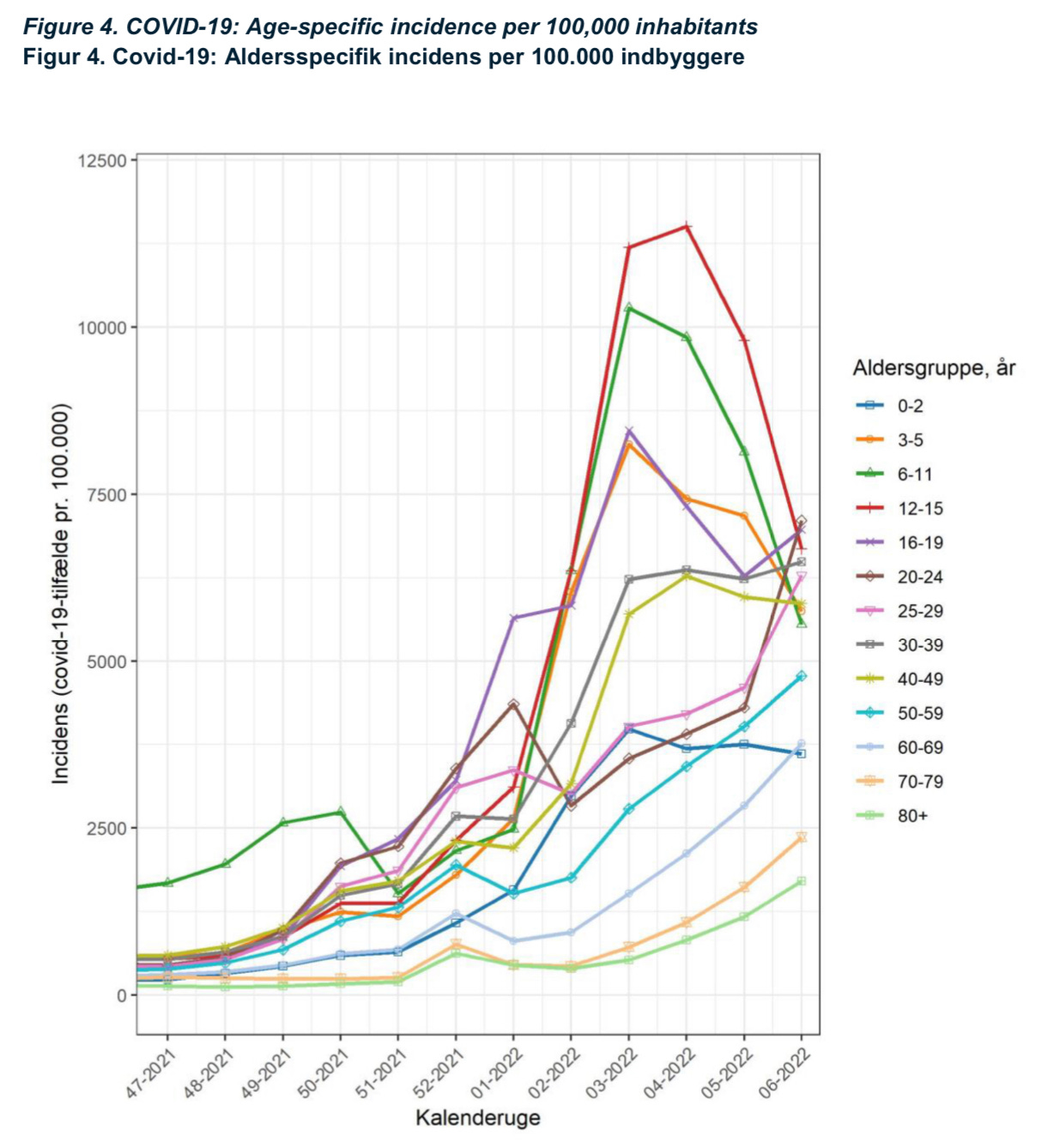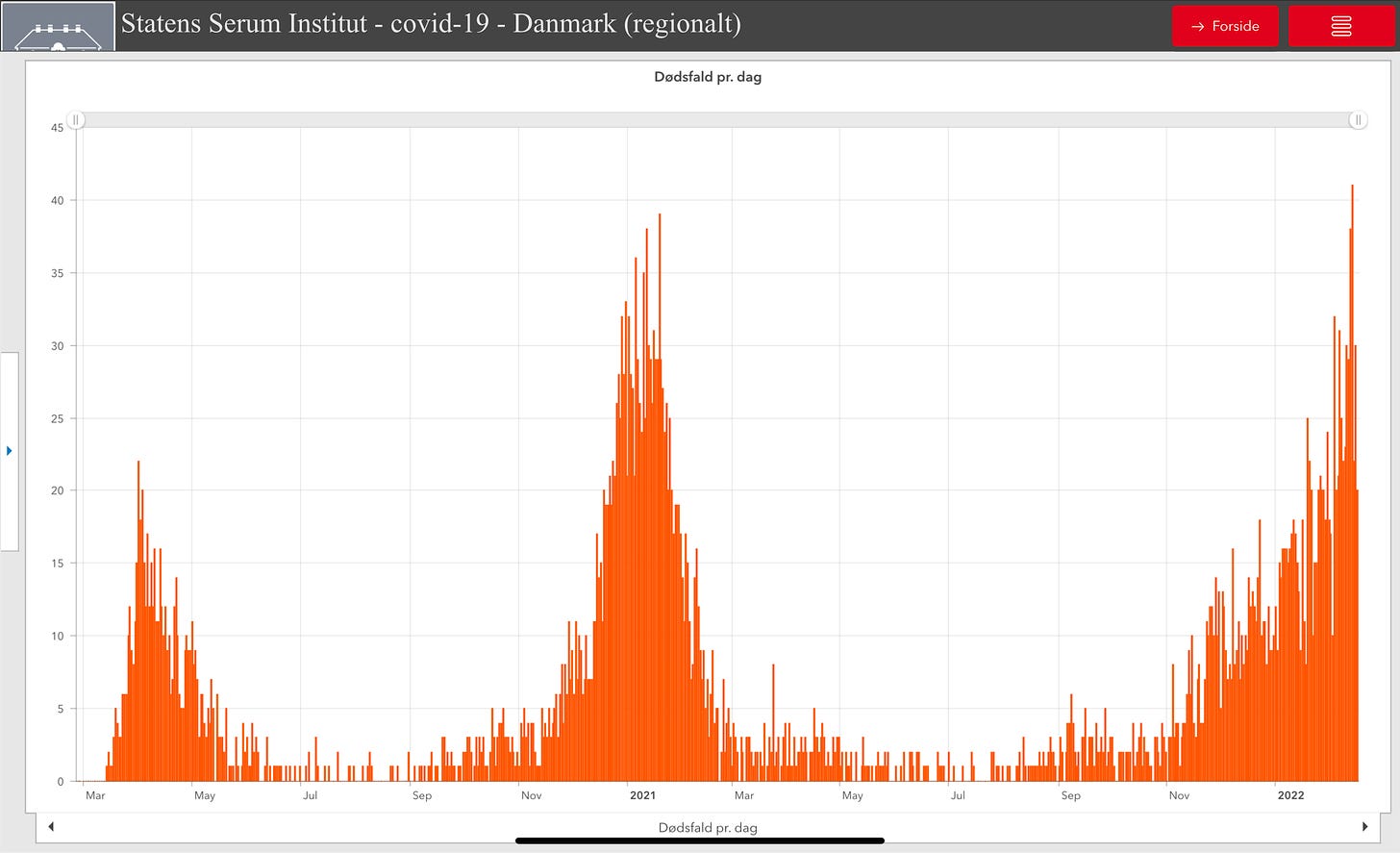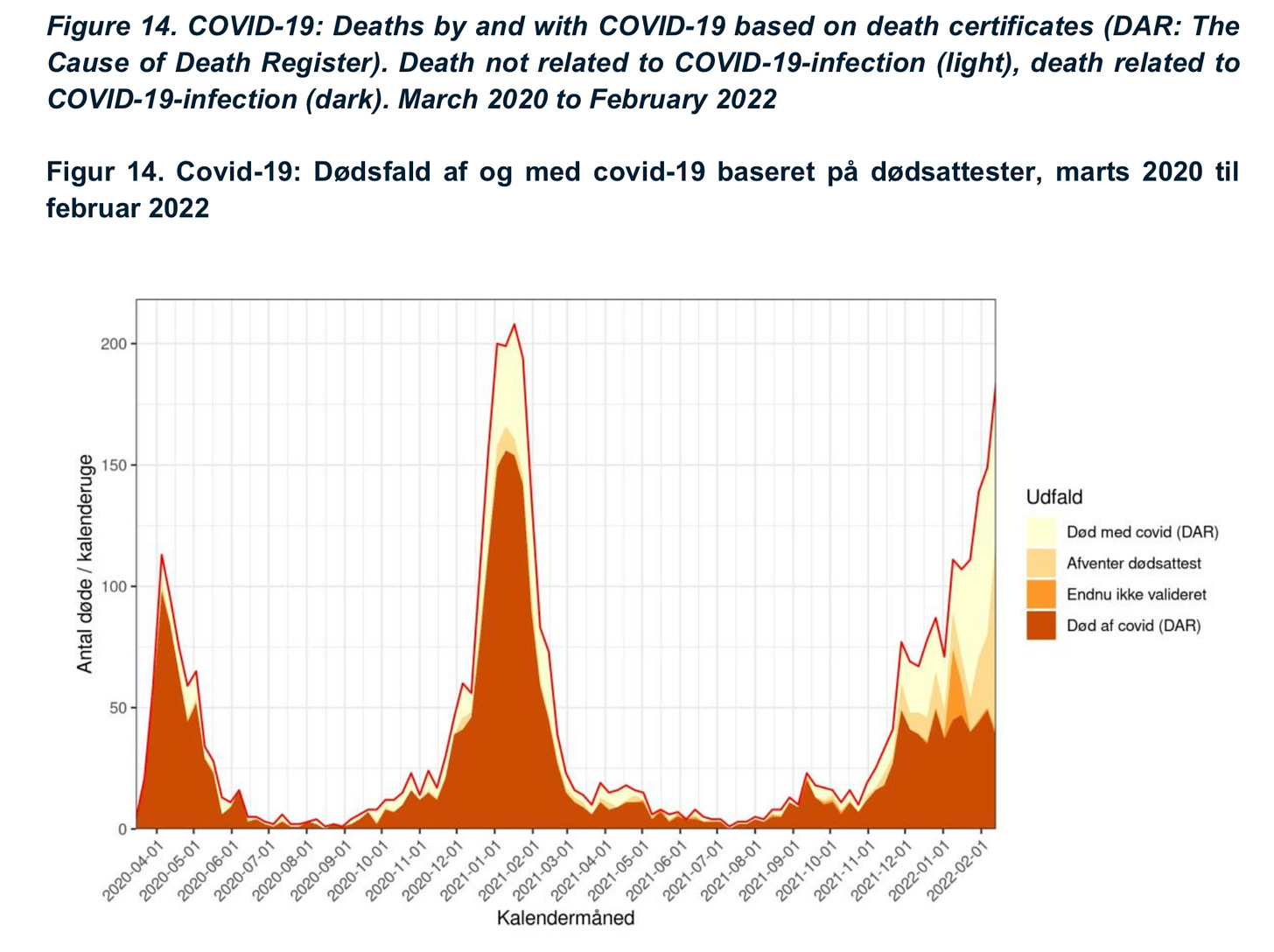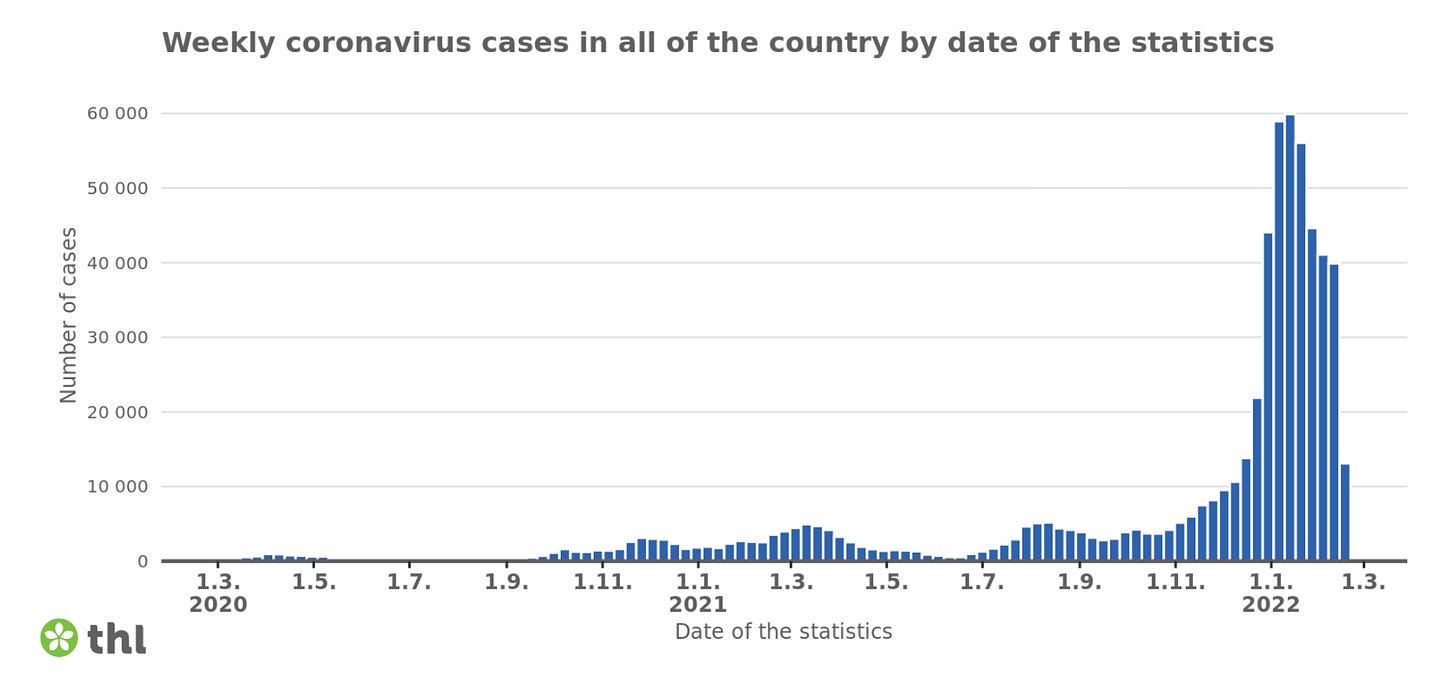🇩🇰
The Omicron-fueled infection wave continues to batter Denmark. Last week, the number of infections increased, the positivity percentage continued to rise, and hospitalizations kept setting new daily record highs.
The latest weekly assessment from the Staten Serum Institut says week-to-week infections increased by 6%, or 5,395 per 100,000 people. The positivity percentage also kept climbing, going from 35.4% one week to 39.8% the next.
North Jutland is now the epidemic epicenter with cases increasing week to week by 27.5%. It also led all regions with a COVID incidence rate per 100,000 people of 7,259 and it had the highest positivity percentage as well, with 44%. The SSI notes infections are continuing to rise across the region. Region Hovedstaden has an incidence rate of 3,795 and while it continues to decline at a regional level, the decreases have stabilized in both the Copenhagen and Frederiksberg municipalities.
Infections seem to be finally dropping among those 15 years old and younger. The COVID incidence rate is highest among 20 to 24 year olds (7,109), followed by 16 to 19 year olds (6,974). A concerning increase in infection activity in Danish nursing homes continues with 2,055 confirmed coronavirus cases last week, which is 408 more infections than the week before. COVID deaths in nursing homes are also rising, going from 61 to 88 from week to week.
The latest snapshot seems to show infection activity declining among school staff, but cases are rising among hospital workers and other healthcare staff.
While infection numbers have become less of an accurate barometer of the epidemic situation, other indicators continue to signal we aren’t out of the pandemic woods yet. One of the them is COVID wastewater surveillance, where the SSI says COVID increases were detected at the national level and in three of Denmark’s five regions.
With hospitalizations setting new record highs on an almost daily basis, it is no surprise that hospital admissions increased last week by about 16%. There were 2,774 people hospitalized in week 6. Hospitalizations increased across all age groups except for 10 to 19 year olds and those 30 to 49 years old. Seniors 90 years old and older had the highest hospital admissions followed by 80 to 89 year olds.
The SSI says the proportion of hospitalizations directly due to a COVID infection continues to fall, hitting 52% in the last week of January. That is down from 55% the week before. Admissions to intensive care due to COVID also edged downward, going from 71% to 67% from one week to the next.
Pandemic deaths increased week to week, with 194 lives lost last week. That is 49 more fatalities than the week before. The SSI says excess mortality was largely back to normal levels except for increases among seniors 85 years old and older. It adds that with delays in death registry data, the numbers should be taken with some caution.
The BA.2 variant continues to reign supreme, making up approximately 92% of all sequenced positive test results last week. That is an increase from the 85% mark from the week previous.
-
In Denmark COVID hospitalizations have reached another record high (1,604) as numbers jumped again (+106) the number of severe infection cases in an ICU (31) is unchanged, and of those the number on a ventilator (14) is also unchanged. Infection admissions to a psych ward (387) crept up (+6).
-
Infection rates since November of last year in Denmark may be 50% higher than reported via positive PCR tests. That is according to a second week’s worth of data from a study trying to determine the ‘true’ infection rate in the country by testing samples from blood donors. The Staten Serum Institut says the infection spread may have been large enough to cover half of all adults in Metro Copenhagen and the rest of the island of Sjælland.
SSI Director Henrik Ullum:
“We now estimate that 44% of the healthy adult population between the ages of 18 and 72 have been infected during the Omicron wave between November 1, last year and February 9, this year. The infection in the Capital Region and also Region Sjælland has been higher than in the rest of the country and it is estimated that half the population have now been infected.”
The SSI teamed up with Blood Donors Denmark to try and determine what it calls “the dark number” of infections. Those are people who had a COVID infection, which was either extremely mild or completely asymptomatic, and never got tested. By testing blood donations each week for COVID antibodies and cross checking with positive PCR tests results, it hopes to determine a more accurate infection count.
The second week of testing included 5,847 blood donors who donated their blood between January 31 to February 6.
The findings so far lead the SSI to think that the COVID “dark figure” makes up between one-third to one-half of all infections.
The institute cautions this assessment is a calculation based on data found, and that because it is an extrapolation it is “subject to considerable uncertainty.”
-
There were 40,600 new infections (underreported), including 2,158 reinfections, and 44 more coronavirus deaths reported in the last day.
Yesterday there were 185,062 total corona tests, of which 130,273 were PCR tests equaling a positivity percentage of 31.16%.
Denmark saw its deadliest day of the pandemic on February 13, with the number I’d confirmed virus fatalities now at 41, two higher than the previous record high set on January 19, 2021, during the Alpha variant wave.
-
For context, the Staten Serum Institut has issued its latest snapshot of pandemic fatalities with the distinction between s people who died - of - COVID compared to the people who died - with - COVID. Last week, an estimated 38.5% of people died with COVID and not because of it.
-
The vaccination campaign continues to wind down with 1,821 booster doses administered yesterday.
To date, 82.5% of the total population have one vaccine dose, 80.9% have two, and 61.6% have a booster dose.
-
In another sign, Denmark wants to be done with the pandemic, even though the pandemic might not be done with it, as the DSB will remove all COVID-related advisory material from its train stations. It will also remove floor and stair stickers, encouraging people to keep their distance.
Communications Head for Denmark’s national rail company Niels-Otto Fisker spoke to Ritzau:
“The markings on the floors and stairs were very worn. Either they had to be renewed or removed. Since the coronavirus is no longer a socially critical disease, we chose to remove them.”
Danish health authorities continue to recommend people keep their distance in crowded spaces, especially if they are indoors.
For almost two years, posters, stickers and other information material in public space have made us aware that we should remember to keep our distance.
Also at DSB, where markings that have unidirectional passengers' direction of traffic.
-
While infection numbers have hit record highs, the number of pandemic related work injuries have not followed the upward curve. The latest weekly reporting from Denmark’s Arbejdsmarkedets Erhvervssikrings found just 900 workplace reports in the first month of the year.
Executive Vice President of ATP Pension and Business Insurance, Anne Kristine Axelsson, says that is a “surprisingly low” number considering the sheer number of infections this year.
In Denmark, if you get infected on the job you can report it as a work injury to your manager or family doctor within a year. This opens up the option to seek compensation for people who struggle with long-COVID after having recovered.
In the last year and a half, almost 12,000 people have reported work-related injuries due to a coronavirus infection. Most of those came from people working in hospitals, senior homes, and daycares.
🇸🇪
Sweden has added 52 corona deaths and 4,097 infections (which are wildly underreported) since yesterday’s update.
ICU numbers (75) have declined (-17).
So far, 86.7% of the population 12 years old and older have one dose, 84.1% have two doses, of those 18 years old and older 57.2% have a booster shot.
-
At least one person involved in the Swedish vaccination effort is sounding a warning about the falling number of inoculations. Head of operations at the Södertälje vaccine clinic Lotta Hallin spoke to SVT to express her concerns with what she sees as lackluster vaccination interest.
“People think they are free of it now, but the pandemic is not over yet.”
-
There are more indications that the Omicron sub-variant BA.2 is gaining ground in Sweden. The latest analysis of COVID wastewater testing by the University of Gothenburg has shown the variant to now be dominant.
Sahlgrenska Academy’s Heléne Nordwr:
“My employees have developed and set the testing types for Omicron BA.1 and BA.2, and the results show that BA.2 seems to have taken over. It also may have arrived much earlier than we thought, it was here already during week 2.”
While wastewater testing showed a dominant BA.2 variant, it also indicated infection levels overall are slowly declining albeit they are still at higher levels than in any previous wave.
-
There are 521 COVID hospitalizations in Sweden’s capital region, which is a day over day decline of 26. The number of infected people getting treatment in an intensive care unit (25) dropped slightly (-2). As of Thursday afternoon, Region Stockholm has 180 empty care beds and the staff to service then, which is 82 more than were available on Wednesday.
-
A new study has begun in Sweden to look at ways to treat respiratory issues associated with long-COVID. According to researchers at Karolinska Hospital breathing problems are one of the most common symptoms of people struggling with COVID symptoms long after they have officially recovered.
Karolinska Physiotherapist and Doctoral student Anna Törnberg:
“Many people describe it to us that it is like they have forgotten how to breathe.”
The study will focus on special training to improve breathing for those battling long-COVID.
🇳🇴
In Norway COVID hospitalizations (402) have increased (+25) the number of severe infection cases in intensive care (44) have edged up (+9) and of those ventilator numbers (21) have dipped (-2).
Norge had no new coronavirus deaths and added 17,674 infections (underreported)
So far, 80.2% of Norwegians 12 years old and older have one dose, 74.5% have two, and 52.9% have a booster shot.
The Norwegian Institute for Public Health has updated vaccination levels among different groups.
12 to 15 year olds - 54% have one dose.
16 to 17 year olds - 83% have one dose and 42% have two.
45 years and older - 81% have a third dose.
65 years old and older - 89% have a booster dose.
Those 18 to 64 years old in a high risk group - 80% have been boosted.
-
Health officials in Norway are expecting the country’s Omicron-driven infection wave to peak in a matter of weeks. According to the latest weekly assessment from the Norwegian Institute of Public Health infection numbers increased again last week by 7% rising from 128,635 cases to 137,762 from week to week. This is in spite of numbers being underreported due to reduced testing and a plethora of self-testing kits.
There were 550 COVID infections, which is 38 more than were admitted the week before. Intensive care numbers continued to drop, going from 18 to 14 from week 4p5 to week 6. The NIPH says 296 (54%) of hospital admissions last week were because of an infection. Looking at admissions by age group, the highest number of COVID hospitalizations per 100,000 people was among infants (35.8) under the age of one followed by seniors over the age of 85 (27.2). The NIPH says infants have a “lower threshold” for hospital admissions as parents concerns tend to be much more heightened with newborns. The health agency says 40% of all hospital admissions for children under the age of 18 are due to a coronavirus infection. It also adds COVID hospitalizations among children are still lower than was seen during the RS virus wave last fall.
The public health agency says of the 253 hospitalizations last week where the vaccination status is known, 33% were unvaccinated; 21% had two doses, and 42% had a booster. Vaccinated people admitted for a coronavirus infection tend to be older and or have underlying healthy conditions increasing infection risk.
There were 34 pandemic fatalities last week slightly down from 40 the week previous. The median age for COVID deaths last week was 82 years old.
As an indicator of the sheer saturation of Omicron wave infections, the institute says the proportion of the population testing positive, as measured by a population survey, increased from 0.5% in mid-December to 6.6% in the second week of February.
On the variant front, the Omicron sub-variant BA.2 accounted for 47% of all sequenced positive test results in week 5, while the number of Delta variants infections was “sporadic.”
🇫🇮
Finland registered 7,953 infections and 23 virus deaths in the last day.
COVID hospitalizations (716) are unchanged.
To date, 79.3% of the total population have one vaccine dose, 75.1% have two doses, and 48.8% have a booster dose.
-
The Omicron infection wave has plateaued in Finland, according to the latest weekly pandemic snapshot from the Finnish Institute for Health. However, while infection numbers level off, the strain on hospitals continues.
There were 359 COVID hospitalizations last week, a slight increase from the week prior, while 32 people were admitted to intensive care, an increase from the 29 for the week before. Severe infection cases accounted for 27% of ICU capacity in Finland last week.
While infection numbers have become a less reliable barometer of the pandemic situation, the agency says other indicators show the Omicron wave is still a concern. Wastewater testing continues to show high amounts of virus activity. COVID levels were stable or slightly increased across most of the country except for the capital region. In Helsinki wastewater surveillance is indicating declining infection activity.
In the last two weeks, the health agency says there have been 230 pandemic deaths. Examining COVID fatalities in January 86% were people who died from a coronavirus infection last month who were over the age of 70 and 63% were older than 80.
As Finland enters a new phase with its pandemic, the health institute says the emphasis will shift to local and regional measures to battle the epidemic. It will also be more and more up to people to take steps to prevent infection spread, including by getting vaccinated and adopting the use of self-testing kits.
-
Finland has some decisions to make on its surplus vaccine doses, and the clock is ticking. The Finnish Institute for Health says by the end of February it will have enough vaccine doses to cover booster shots for everyone who is eligible in the country. This despite up to 1.4 million more doses arriving every month until this fall.
With a shelf life of about seven months, the agency says now is the time to make some decisions about what to do with all the excess doses.
Chief Specialist Mia Kontio spoke to YLE:
“Decisions should be made within the next few weeks, so that the vaccines can be routed elsewhere directly from production plants.”
To date, Finland has donated 5.4 million vaccine doses to the international COVAX initiative, which procures vaccines for developing countries.
🇩🇪
Germany recorded 235,626 infections and 261 virus deaths since yesterday’s update.
It added 1,630 COVID hospitalizations while ICU numbers (2,466) dropped (-26).
So far, 76.2% of the total population have one dose, 75% have two, 55.9% have a booster dose.
🇦🇹
Austria will scrap almost all of its COVID restrictions next month. Restrictions will begin to be lifted this Saturday when mandatory proof of vaccination mandates will be abolished and people will no longer need a coronapas to eat in a restaurant or attend events. On March 5, nightclubs, restaurants, and bars can all return to normal operations. A few measures will continue to remain in place including the requirement to wear a mask in shops, pharmacies, and on public transit.
🇳🇱
An independent commission has slapped the hands of the Dutch government for its pandemic response. The review of the first year of the pandemic in the Netherlands found the government was not prepared, retirement homes were left vulnerable, and there was no overall response plan. The ramifications of leaving retirement communities unprotected led to “a catastrophe in the shadows” according to the report. The 300 page report says without a proper pandemic response plan, politicians were left to scramble, focusing on hospitalizations and infection rates while virtually ignoring economic, educational, and cultural ramifications. It is the first of three reviews of the government’s pandemic response and management.
The Netherlands is planning to lift all of its coronavirus restrictions by February 25.
🇪🇺🦠
The European Centre for Disease Prevention and Control has published its latest COVID risk assessment map. The EU remains painted entirely in high-risk deep crimson.
WHO🦠
The World Health Organization is warning countries to not rush headlong into lifting all COVID restrictions when the pandemic is not over yet.
Executive Director of the WHO’s Health Emergencies Programme, Dr. Mike Ryan, says the idea of just abandoning all restrictions right now is premature.
“We do recognize this desire to open up. This desire to go back to normal. But if that desire to go back to completely normal in that sense is going to sustain the pandemic going forward for much longer than it needs to be the we really need to think about that. I do think that in some situations, the political pressure now to open up and remove all restrictions of all kinds is so high that we may overshoot the runway and we may end up in a situation where - and again I am acknowledging uncertainty. I am not sure that will happen, and I am not predicting that will happen but I am a bit nervous right now that we’re sort of just lifting everything. If we get hit with another variant and we’ve already sort of abandoned all measures, it is going to be really hard to put anything back in place.”
WHO COVID Technical Lead Dr. Maria Van Kerkhove concurs.
“The problem is that we have seen too many countries sort of lift it all, and then put it all back in, and lift it all, and put it back in, whereas other countries have really done this slow step-wise approach. And what we’re seeing right now, we hear in the news countries that are lifting everything. In some countries, they’re in a better position to be able to do that because they have high levels of vaccination coverage and high levels of population-level immunity and they have the ability to adjust. But in many other countries it is ill-advised to lift everything all at once. We just need to have countries not do this all-or-nothing approach because it’s confusing and I don’t blame anyone that’s out there that is confused. But what is important for you to hear out there, which I hope is empowering, is that you have some control over this.”
🇯🇵
A concerning study has emerged in Japan finding that the Omicron sub-variant may cause more severe infections. Researchers in Japan did laboratory experiments infecting hamsters with both the parent Omicron variant (BA.1) and its sub-strain (BA.2). They found that hamsters infected with BA.2 became sicker and had more serious respiratory issues including poorer lung function and longer-lasting damage to their lungs.
The BA.2 has been confirmed in at least 74 countries around the world. In Denmark, the Staten Serum Institut estimates the sub-variant to be 1.4 times more contagious than the already hyper-infectious Omicron variant.
The study was a preprint and has not been peer-reviewed. It was published on the scientific journal site bioRvix.
🇨🇦
Canada has added another COVID vaccine to its arsenal. On Thursday, Health Canada approved the Novavax vaccine for use on adults. The two dose vaccine registered an efficacy rate of 90% in preventing symptomatic infection and 100% protection against severe coronavirus cases, according to a press release from the company.
This particular vaccine is significant for Canada because the federal government signed a deal with the company in February of last year to produce Novavax doses at a Montreal-area facility. This would be a significant asset in the future allowing the country to rely less on importing vaccine doses from abroad.
Novavax is a protein-based vaccine using tiny inactivated fragments of the COVID virus to trigger an immune response in the body.
Europe approved the Novavax vaccine for use on December 20.
-
Canada suffered 108 more coronavirus deaths on Wednesday, as total to-date pandemic deaths will likely pass 36,000 over the next two or three days. It added 8,016 new infections, but those numbers are likely extremely underreported due to limited or overwhelmed testing across the provinces.
The national positivity percentage over the last seven days is 13.8%.
The Canadian vaccination effort has so far administered 32,107,717 1st vaccine doses (83.79% of the total population) while 30,690,973 people (80.27%) have two doses, and of those, 17,127,211 people are fully vaccinated with three shots.
All changes in hospitalization numbers below are reflective of the difference from our last report on Tuesday.
In Ontario, COVID hospitalizations (1,342) have dropped (-208) while the number of severe infections in intensive care (356) has declined (-28). 52% of hospital admissions and 80% of those admitted to intensive care were directly because of a COVID infection. Another 37 pandemic deaths were reported. The province has a positivity percentage of 12.60%.
Quebec saw hospitalizations (1,902) drop (-150) while the number of severe infections in an ICU (124) also fell (-8). There were 22 more corona deaths. The province has a positivity percentage of 9.58%.
Newfoundland and Labrador has 16 COVID patients in hospital (+2) with 5 people in an ICU (-1). There has also been one more pandemic death. The province has a positivity percentage of 25%.
New Brunswick saw hospitalizations (79) dropped (-22) while ICU numbers (0) declined (-2). The province reported one more pandemic death. It has a positivity percentage of 20.72%.
In Nova Scotia hospitalizations (66) are down (-8) while there are 11 people in intensive care, which is unchanged. It also reported two more corona deaths. The province has a positivity percentage of 12%.
Manitoba saw COVID hospitalizations (607) decline (-7). It has suffered five more pandemic deaths. The province has a five-day positivity percentage of 19.1%.
Saskatchewan has record high hospitalizations (410) which have jumped (+26) since last Thursday’s update. There are 33 people in an ICU. It reported 42 more corona deaths. The province has a positivity percentage of 20.87%.
Alberta has a positivity percentage of 27.06%. There were another 18 deaths. COVID hospitalizations (1,491) dropped (-47) while the number of people in an ICU (116) dipped (-4).
B.C. saw COVID hospitalizations (744) fall (-43) while the number of people with severe infections in an ICU (120) also dipped (-4). There have been five more pandemic deaths in the last day. The province has a positivity percentage of 13%.

















